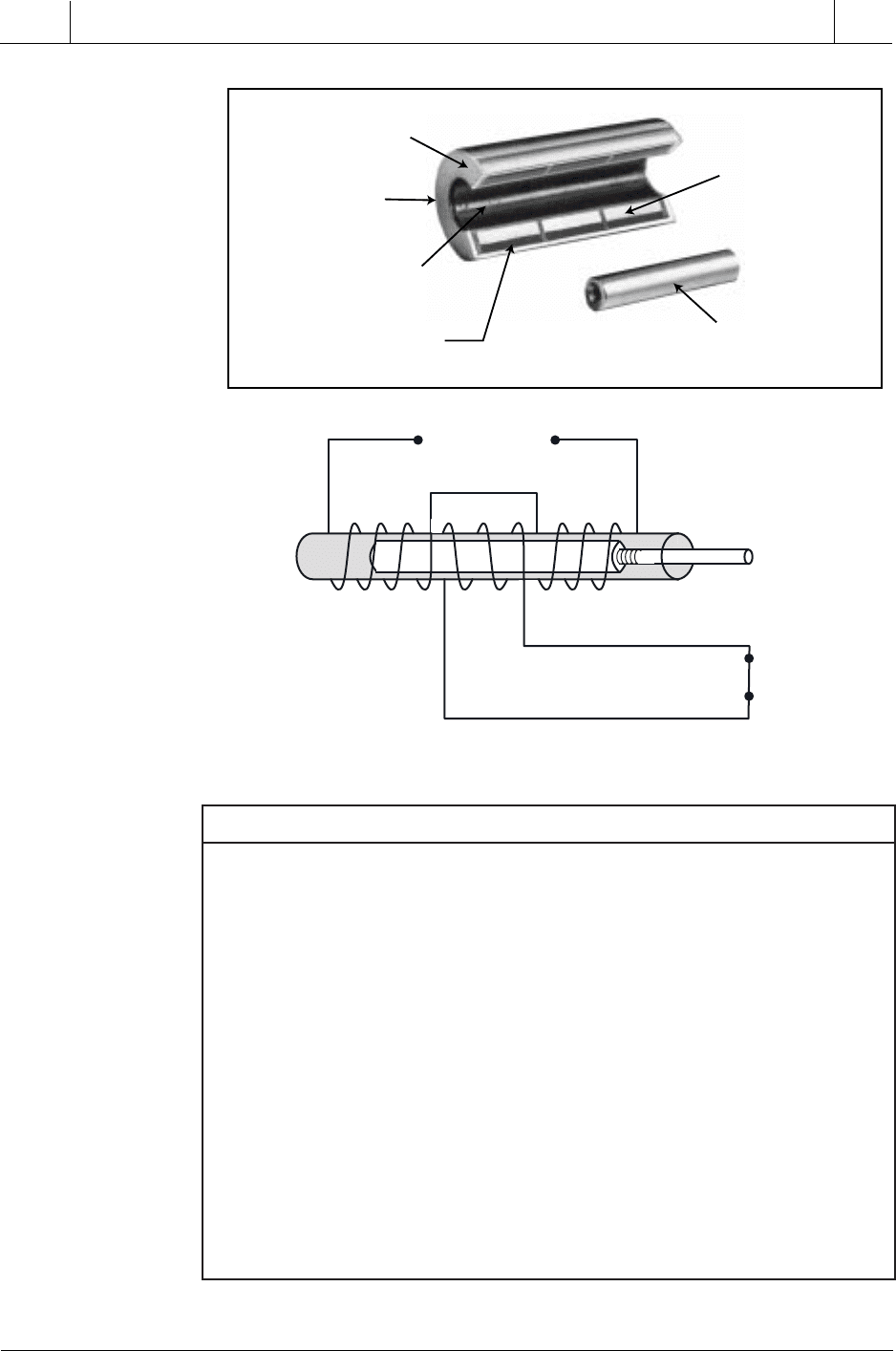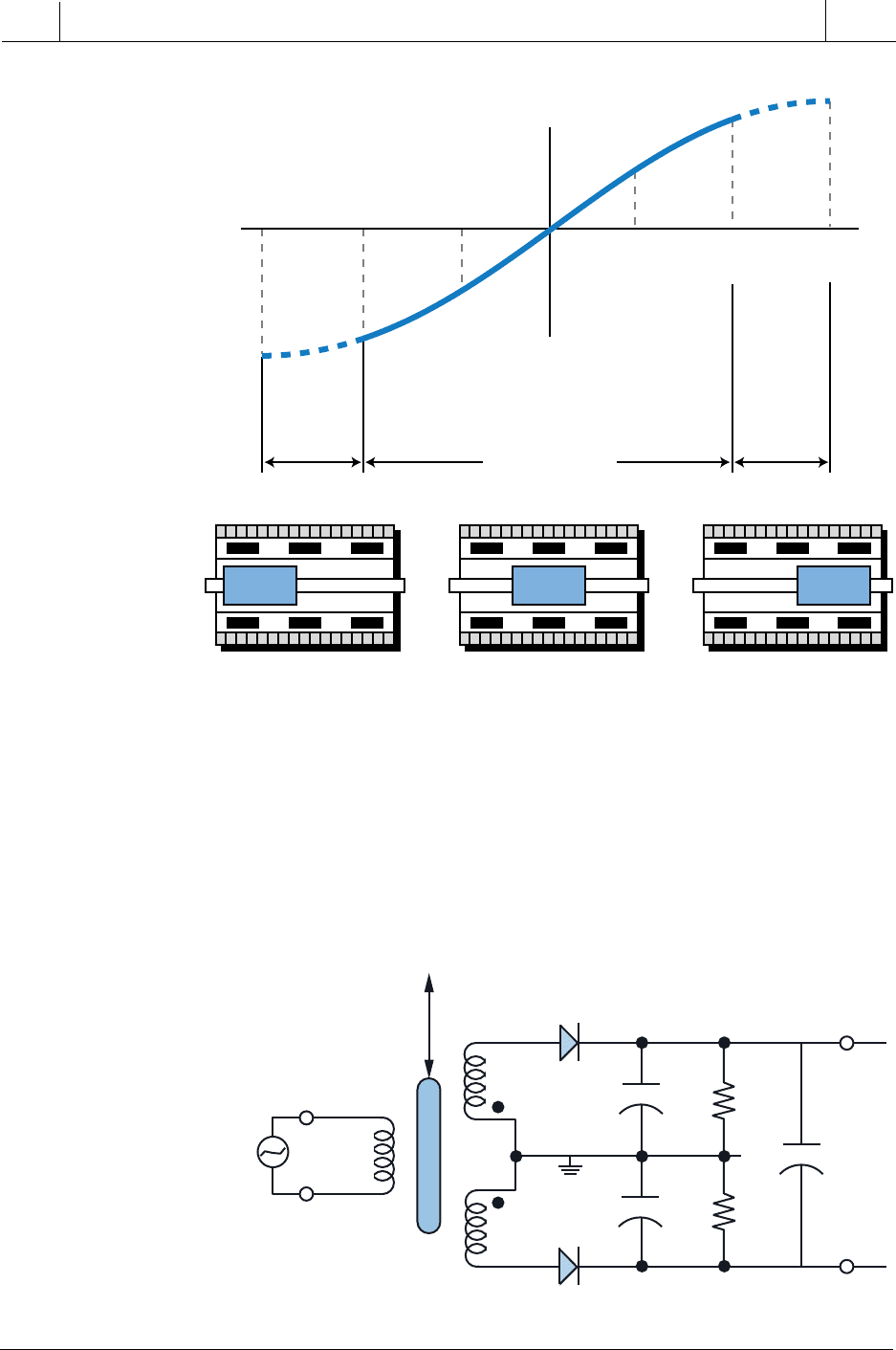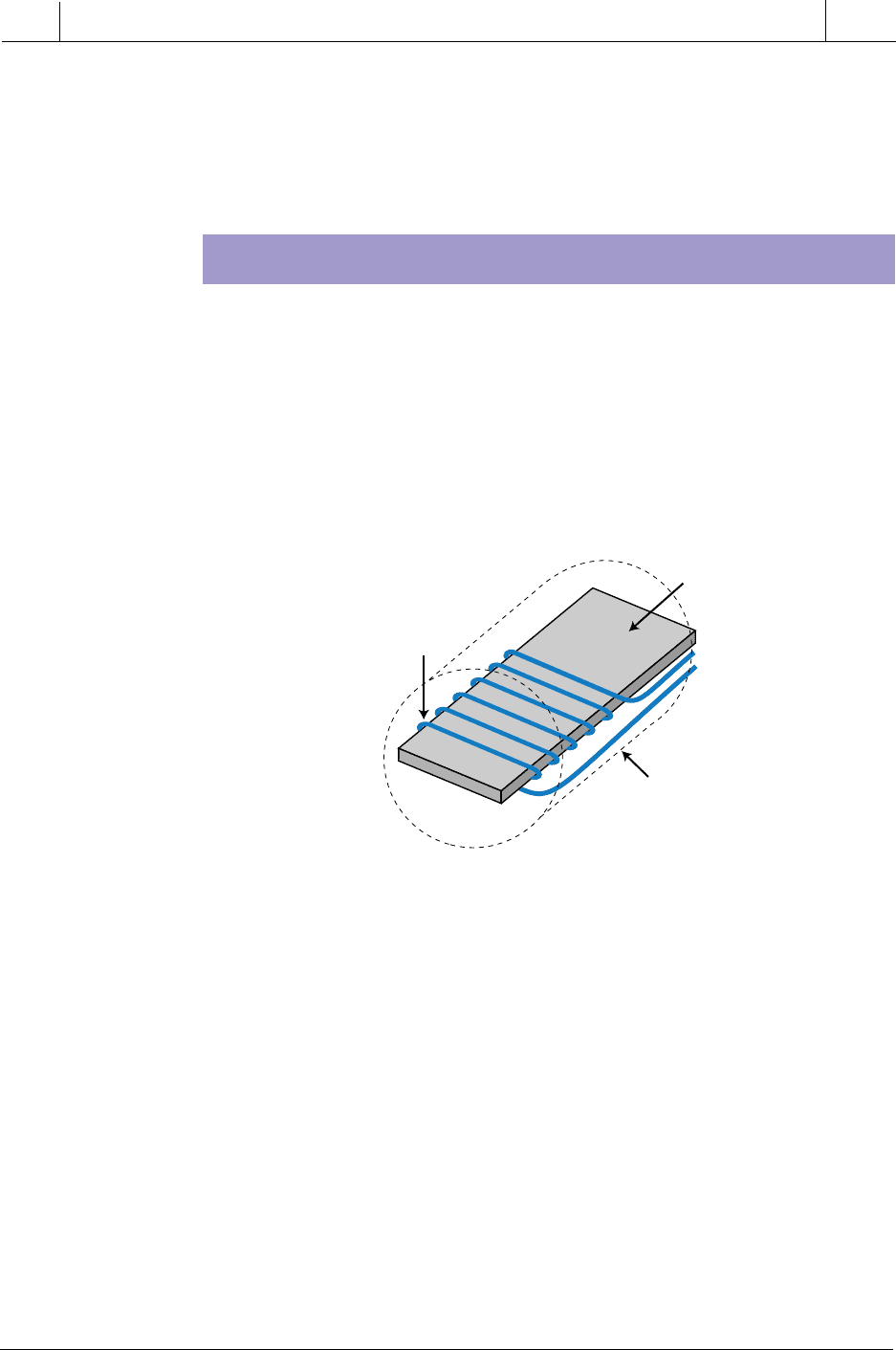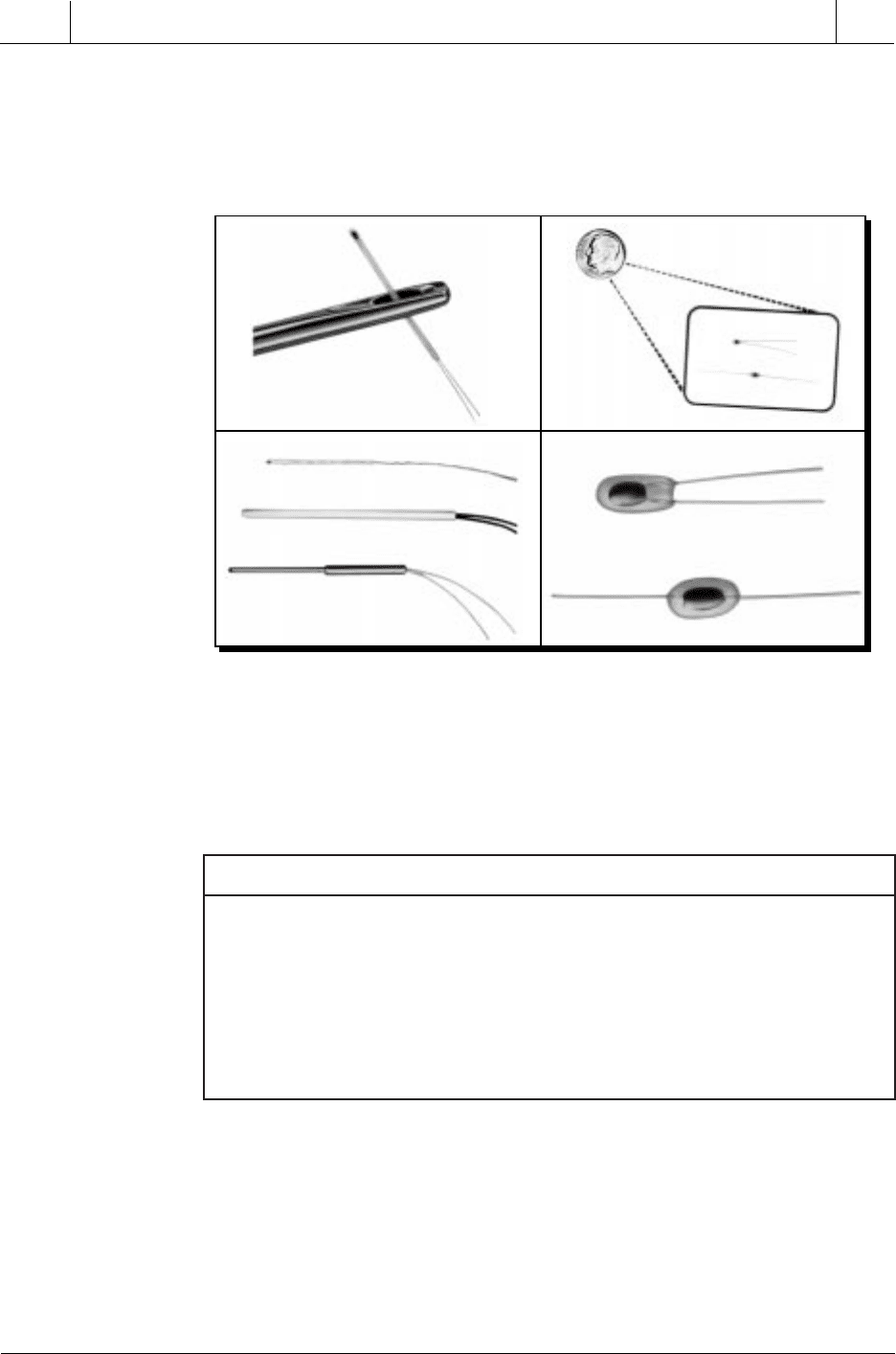Bryan L. Programmable controllers. Theory and implementation
Подождите немного. Документ загружается.


569
CHAPTER
13
Data Measurements
and Transducers
Industrial Text & Video Company 1-800-752-8398
www.industrialtext.com
SECTION
4
PLC Process
Applications
Figure 13-5. Bridge circuit.
∆
ΩΩ
Ω
RRR
B
444
10 11
1
=−
=−
=
K K
K
The current measurement is defined by (values of
R
in KΩ):
I
VR
RRRR RR
D
iBDB
R
R
R
R
=
+
(
)
++
[]
+
(
)
++
[]
=
+
(
)
++
[]
+
(
)
++
[]
=
=
∆
4
24 34
11
24 1
011 8 10 031 10 10
24
18 2 20 675
0 06378
2
1
3
1
8
8
10
8
mA
()()
..
(.)(. )
.
LVDT TECHNIQUES
A linear variable differential transformer (LVDT) is an electromechani-
cal mechanism that provides a voltage reference that is proportional to the
displacement of a core inside a coil. Figure 13-6 illustrates a cutaway and a
diagram of an LVDT, while Table 13-2 lists the types of transducers that use
LVDT mechanisms.
An AC voltage, when applied to the primary coil, creates an induced voltage
in the secondary coils of an LVDT. As the LVDT’s core (which is made of
a magnetic material) moves, the voltage at the output of the secondary coil
changes. The induced voltage created by the core movement and the way the
secondary coils are wound determine the value of the voltage change (see
Figure 13-7). The secondary coil is wound in the opposite direction of the
primary, so that the induced voltage will change polarity as the coil moves.
R
1
= 8 KΩ
R
i
= 100
R
3
= 10 KΩ
R
4
= 10 KΩ
R
2
= 8 KΩ
24 VDC
300 Ω
D
AB

570
SECTION
4
PLC Process
Applications
Industrial Text & Video Company 1-800-752-8398
www.industrialtext.com
CHAPTER
13
Data Measurements
and Transducers
Figure 13-6. (a) Cutaway and (b) diagram of an LVDT.
Table 13-2. Transducers that use LVDT mechanisms.
recudsnarTstnemerusaeMdnasesU
llecdaoLgnitsetelisnet,thgiew,ecrof,euqroT
ebutnodruoBytisoropemulov,erusserpdiulf,erusserP
mgarhpaid,swolleB erusserpegnar-wol,erusserpdiulf,erusserP
stnemerusaem
laenilTDVLtnemerusaemlevel,tnemecalpsidlaeniL
retemonaM htiwdiuqilfonmulocafothgiehehtgnirusaeM
ytisnednwonka
eguagTDVL gniguag,srotacidninoitisoplaidlacinahceM
stnemerusaem)llamsyrev(tnemecalpsiddna
retemoreleccAovres,sexaeromroenoninoitareleccA
smetsyscimsies,snoitacilppagninoitisop
retemonilcnIenilcni,gnisnesleveL
ytimixorpecnatculerelbairaV
rotceted
stcejbocitengamorreffonoitcetedytimixorP
(a)
(b)
Stainless steel housing and end
lids provide electrostatic and
electromagnetic shielding.
Housing is spun-swagged
over end lids to produce
tight seal
High density, glass filled pol-
ymer coil form has low mois-
ture absorption and excellent
thermal stability. Coil movement
due to moisture breathing is eliminated
Vacuum and pressure im-
pregnation with high
grade electrical varnish
adds additional mois-
ture proofing, thermal
stability, and structural
integrity to the coils
Epoxy Encapsulation assures
proper heat transfer and bonding
of coils to housing
High permeability, nickel-iron hydro-
gen-annealed core for low harmonics,
low null voltage, and high sensitivity
Coil
Core
Courtesy of Schaevitz Engineering, Pennsauken, NJ
Primary
Secondary Secondary
Output Voltage
Input Voltage

571
CHAPTER
13
Data Measurements
and Transducers
Industrial Text & Video Company 1-800-752-8398
www.industrialtext.com
SECTION
4
PLC Process
Applications
Modern LVDTs provide demodulation, or rectification, circuits to convert
the secondary output into a DC voltage signal. This voltage signal is in linear
proportion to the core movement within its range. The resultant voltage when
the core is at its starting position is +V; when the core is at its end position the
resultant voltage is –V. When the core is at the middle, it provides a null, or
zero, voltage output. Figure 13-8 illustrates a simple demodulator circuit for
an LVDT.
Figure 13-8. Demodulator circuit for an LVDT.
Figure 13-7. LVDT core movement and output voltage.
Core at –100% Core at 0
(Null Position)
Core at –100%
(–) (+)
Voltage Out
(+)
Voltage Out
Opposite Phase
Nominal Range
Linear Range
(–)
150 100 50
50 100 150
Core Position (% Nominal Range)
Extended
Range
Reduced
Linearity
Extended
Range
Reduced
Linearity
C1
Primary
Output
Power
Input
Motion
Input
C1
D1
C2
D2
Secondary
1
2
1
2
1

572
SECTION
4
PLC Process
Applications
Industrial Text & Video Company 1-800-752-8398
www.industrialtext.com
CHAPTER
13
Data Measurements
and Transducers
EXAMPLE 13-5
Graphically illustrate the position of an LVDT core that has a total
displacement range of 20 inches and an output of ±10 VDC.
Figure 13-9. Position of example LVDT core.
13-4 THERMAL TRANSDUCERS
Thermal transducers sense and monitor changes in temperature. Either the
process itself or induced heating/cooling process control inputs may cause
these temperature changes. There are two primary types of thermal transduc-
ers. The first type measures internal resistance changes due to temperature
variations; the second type measures voltage differentials as a result of
temperature variations.
Thermal transducers provide at their output, after conditioning, voltage or
current signals proportional to the temperature measurement range. De-
pending on the transducer and the PLC used, special input modules or analog
input interfaces input this temperature data into the controller. An under-
standing of thermal transducer operation will help you know how and where
to use these transducers in a process control application.
noitisoPeroCnoitisoPraeniLtuptuOegatloV
%001–taeroC"0CDV01–
)llun(%0taeroC"01CDV0
%001+taeroC"02CDV01+
SOLUTION
Figure 13-9 shows the graph for this LVDT core.
+10 VDC
–10 VDC
–100%
0%
+100%
0"
10"
20"
Voltage

573
CHAPTER
13
Data Measurements
and Transducers
Industrial Text & Video Company 1-800-752-8398
www.industrialtext.com
SECTION
4
PLC Process
Applications
There are many types of thermal transducers in the marketplace; however, this
section only discusses the most commonly used ones: resistance temperature
detectors (RTDs), thermistors, and thermocouples. RTDs and thermistors are
internal resistance–type transducers, while thermocouples measure voltage
differentials.
RESISTANCE TEMPERATURE DETECTORS (RTDS)
Resistance temperature detectors (RTDs) are temperature transducers
made of conductive wire elements. The most common types of wires used in
RTDs are platinum, nickel, copper, and nickel-iron. A protective sheath
material (protecting tube) covers these wires, which are coiled around an
insulator that serves as a support. Figure 13-10 shows the construction of an
RTD. In an RTD, the resistance of the conductive wires increases linearly
with an increase in the temperature being measured; for this reason, RTDs are
said to have a positive temperature coefficient.
Figure 13-10. Resistance temperature detector.
RTDs are generally used in a bridge circuit configuration. Figure 13-11
illustrates an RTD in a bridge circuit. As mentioned in the previous section,
a bridge circuit provides an output proportional to changes in resistance.
Since the RTD is the variable resistor in the bridge (i.e., it reacts to
temperature changes), the bridge output will be proportional to the tempera-
ture measured by the RTD.
As shown in Figure 13-11, an RTD element may be located away from its
bridge circuit. In this configuration, the user must be aware of the lead wire
resistance created by the wire connecting the RTD with the bridge circuit. The
lead wire resistance causes the total resistance in the RTD arm of the bridge
to increase, since the lead wire resistance adds to the RTD resistance. If the
RTD circuit does not receive proper lead wire compensation, it will provide
an erroneous measurement.
Resistive
Element
Insulator
Protective
Sheath

574
SECTION
4
PLC Process
Applications
Industrial Text & Video Company 1-800-752-8398
www.industrialtext.com
CHAPTER
13
Data Measurements
and Transducers
Figure 13-11. RTD in a bridge circuit.
Figure 13-12 presents a typical wire compensation method used to balance
lead wire resistance. The lead resistances of wires L1 and L2 are identical
because they are made of the same material. These two resistances, R
L1
and
R
L2
, are added to R
2
and R
RTD
, respectively. This adds the wire resistance to two
adjacent sides of the bridge, thereby compensating for the resistance of the
lead wire in the RTD measurement. The equations in Figure 13-12 represent
the bridge before and after compensation. Note that R
L3
has no influence on
the bridge circuit since it is connected to the detector (e.g., input module,
amplifier, etc.).
Figure 13-12. RTD bridge configuration with lead wire compensation.
R
1
R
3
R
RTD
R
2
D
V
R
1
R
3
R
RTD
R
L3
R
L2
R
L1
R
2
D
V
R
R
R
R
R
R
R
RRR
R
RR
R
RR
RTD
RTD L L
L RTD L
1
2
3
1
2
3
12
1
21
3
2
=
=
++
+
=
+
without lead wire consideration
taking lead wire into consideration
(no compensation)
taking lead wire into consideration
(with compensation)

575
CHAPTER
13
Data Measurements
and Transducers
Industrial Text & Video Company 1-800-752-8398
www.industrialtext.com
SECTION
4
PLC Process
Applications
As mentioned previously, the changes in RTD resistance are proportional to
changes in temperature. The following equation defines these resistance
changes:
R R TT TT
TT
=+−+−
[]
0
1
1020
2
αα
()()
where:
RT
RT
T
T
=
=
°
=
=
the change in resistance at temperature
the RTD resistance at a reference temperature point
(e.g., copper is 10 at 25 C)
a constant per degree Celsius that varies with the first
RTD material
a constant per degree Celsius that varies with the second
RTD material
2
0
0
1
Ω
α
α
When an RTD is connected to a PLC’s RTD input module, the interface
determines the temperature (T) based on changes in resistance R
T
. The module
stores this value, which is calculated through an equation that corresponds to
the RTD’s type of input (e.g., copper), in a table. During this process, the input
module also compensates for lead wire connections.
If an RTD is used with a standard analog input module, the user must design
the bridge circuit, as well as the amplifier, so that the signal matches that of
the input module range (e.g., 0 to 10 VDC). To do this, the PLC must
compute the temperature by determining the temperature-versus-voltage
curve. It determines this linear curve by analyzing another curve, the resis-
tance-versus-temperature curve. It then computes the temperature using the
temperature-versus-VDC equation or the linear interpolation look-up table
for the input count value of the analog input voltage. This technique can be
used with any transducer that uses a bridge circuit for signal detection (e.g.,
thermistor, strain gauge, etc.). If the transducer’s temperature detection range
is linear with respect to resistance, the PLC can use an equation to compute
the temperature. If the transducer’s temperature detection range is not linear,
the PLC must perform a linear interpolation based on a look-up table. Chapter
7 explains linear equations in analog readings, while Chapter 11 provides
examples of linear interpolations of analog readings.
THERMISTORS
Like RTDs, thermistors (see Figure 13-13) are temperature transducers that
exhibit changes in internal resistance proportional to changes in temperature.
Thermistors are made of semiconductor materials, such as oxides of cobalt,
nickel, manganese, iron, and titanium. These semiconductor materials
exhibit a temperature-versus-resistance behavior that is opposite of the
behavior of RTD conducting materials. As the temperature increases, the

576
SECTION
4
PLC Process
Applications
Industrial Text & Video Company 1-800-752-8398
www.industrialtext.com
CHAPTER
13
Data Measurements
and Transducers
resistance of a thermistor decreases; therefore, a thermistor is said to have a
negative temperature coefficient. Although most thermistors have negative
coefficients, some do have positive temperature coefficients.
Figure 13-13. Different types of thermistors.
Thermistors can be classified into two major groups: bead thermistors and
metallized-surface thermistors. Table 13-3 lists the types of thermistors that
fall under these categories. Each of these two groups of thermistors offer
advantages and disadvantages, as shown in Table 13-4.
Table 13-3. Classification of thermistors.
Thermistors experience a much greater change in resistance than RTDs.
Figure 13-14 illustrates a graph of the temperature-versus-resistance ratio
for thermistors (R
T
/R at 25°C, where R
T
is the resistance at temperature T).
The graph shows that thermistors experience a large change in resistance
with relatively small increases in temperature. An advantage to these abrupt
changes in resistance is that a thermistor can provide better resolution than an
srotsimrehTepyT-daeB srotsimrehTtcatnoCecafruS-dezillateM
sdaeberaBscsiD
sdaebdetaoc-ssalGspihC
seborpssalGsekalF
)seborpdaellaixa(sdorssalGsdoR
)erusolcneroebut(ssalg-ni-daeBsrefawrosrehsaW
Courtesy of Thermometrics, Inc., Edison, NJ

577
CHAPTER
13
Data Measurements
and Transducers
Industrial Text & Video Company 1-800-752-8398
www.industrialtext.com
SECTION
4
PLC Process
Applications
Table 13-4. Advantages and disadvantages of thermistor types.
Figure 13-14. Temperature-versus-resistance curve (
R
T
/
R
@ 25°C).
Courtesy of Thermometrics, Inc., Edison, NJ
epyTsegatnavdAsegatnavdasiD
epyt-daeB
srotsimreht
tnellecxeotdooG•
eraseriwdael,ytilibats
ssalgnideveilerniarts
laescitemreh
dnagnitarepohgiH•
serutarepmetegarots
elbaliavasezisrellamS•
semitesnopsertsaF•
ecnatsiserdaorbyllamroN•
roftsochgih,secnarelot
secnarelotesolc
noitapissidwolotmuideM•
stnatsnoc
evitsiserrosriapdehctaM•
rofderiuqereragniddap
ytilibaegnahcretni
ecafrus-dezillateM
epyt-tcatnoc
srotsimreht
rethgityllamroN•
roftsocrewol,secnarelot
secnarelotesolc
rofstinuelgnistsoc-woL•
ytilibaegnahcretni
noitapissidmuideM•
stnatsnoc
,ytilibatsdoogotetaredoM•
hgihniatboottluciffid
citemrehtuohtiwytilibats
laes
dnagnitarepodetimiL•
serutarepmetegarots
elbaliavasezismuideM•
semitesnopsermuideM•
Resistance - Temperature Characteristics
Platinum RTD
(100 Ohms at 0° C)
-75
.0001
.0002
.0004
.0006
.0008
.001
.002
.004
.006
.008
.01
.02
.04
.06
.08
.1
.2
.4
.6
.8
1
2
4
6
8
10
20
40
60
80
100
-50 -25 0 25 50 75 100 125 150 175 200 225 250 275 300
5
6
7
8
9
10
11
12
13
14
15
16
Temperature (°C)
Resistance Ratio
(RT/R25°C)
116
Curves
1
2
3
4

578
SECTION
4
PLC Process
Applications
Industrial Text & Video Company 1-800-752-8398
www.industrialtext.com
CHAPTER
13
Data Measurements
and Transducers
RTD for certain temperature ranges. Therefore, thermistors provide more
accurate readings when the span of measurement is narrow. For example, a
thermistor with a 1 MΩ resistance at 25°C will have a resistance of approxi-
mately 300 KΩ at 50°C, meaning that the resistance changes by 28 KΩ for
every 1°C temperature change. Energy management applications, which
have narrow temperature spans and need accurate control measurements,
may require this type of resolution.
A thermistor’s resistance as a function of temperature can be defined by:
RRe
TT
T
=
−
0
0
11
β
where:
RT
T
T
T
=
=° °
=°
=
the thermistor resistance at absolute temperature
C plus 273 (absolute temperature)
the temperature reference (absolute K)
a constant between 3400 and 4000 absolute degrees,
depending on the type of thermistor used
0
β
As indicated in the previous equation and the resistance ratio graph in
Figure 13-14, the resistance change in a thermistor is proportional to the
natural logarithm of the temperature, indicating rapid changes in resistance in
response to changes in temperature. When using thermistors, the temperature
measurement range should not exceed 100 to 150°C, so that the temperature-
versus-resistance ratio is linear. Table 13-5 compares the advantages and
disadvantages of thermistors and RTDs.
epyTsegatnavdAsegatnavdasiD
rotsimrehTesnopsertsaF•
ezisllamS•
etanimilesecnatsiserhgiH•
smelborpecnatsiserdaeltsom
kcohsybdetceffaton,degguR•
noitarbivro
evisnepxenI•
raenilnoN•
ralugnisynarofnapsworraN•
tupni
detimilytilibaegnahcretnI•
desuerasriapdehctamsselnu
DTRegnarediwrevoraeniL•
egnarerutarepmetediW•
egnarerutarepmethgiH•
ediwrevoelbaegnahcretnI•
egnar
hgihtaytilibatsretteB•
serutarepmet
ytivitisneswoL•
evisnepxeeroM•
gnisnestniopoN•
noitarbivdnakcohsybdetceffA•
noitarepoeriw-4ro-3seriuqeR•
tcatnocybdetceffaebnaC•
ecnatsiser
Table 13-5. Advantages and disadvantages of thermistors and RTDs.
